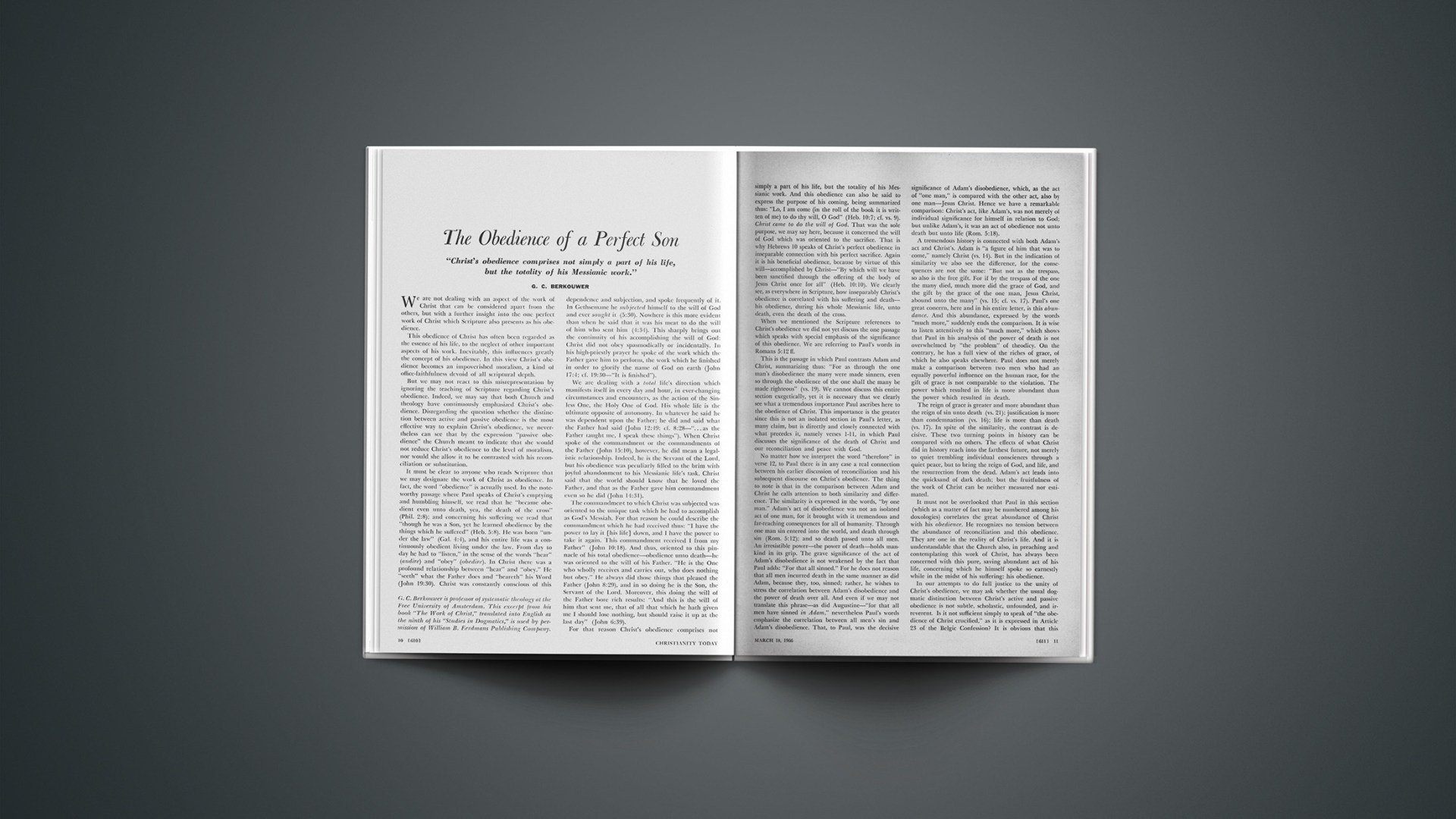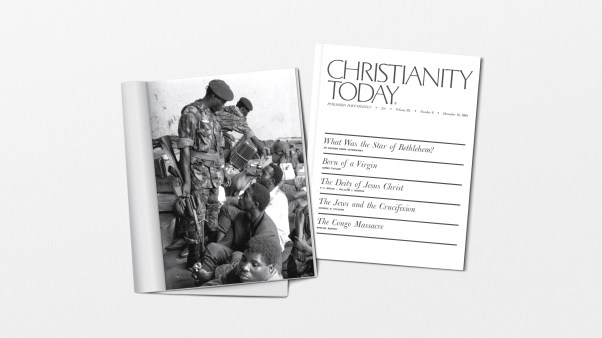“Christ’s obedience comprises not simply a part of his life, but the totality of his Messianic work.”
We are not dealing with an aspect of the work of Christ that can be considered apart from the others, but with a further insight into the one perfect work of Christ which Scripture also presents as his obedience.
This obedience of Christ has often been regarded as the essence of his life, to the neglect of other important aspects of his work. Inevitably, this influences greatly the concept of his obedience. In this view Christ’s obedience becomes an impoverished moralism, a kind of office-faithfulness devoid of all scriptural depth.
But we may not react to this misrepresentation by ignoring the teaching of Scripture regarding Christ’s obedience. Indeed, we may say that both Church and theology have continuously emphasized Christ’s obedience. Disregarding the question whether the distinction between active and passive obedience is the most effective way to explain Christ’s obedience, we nevertheless can see that by the expression “passive obedience” the Church meant to indicate that she would not reduce Christ’s obedience to the level of moralism, nor would she allow it to be contrasted with his reconciliation or substitution.
It must be clear to anyone who reads Scripture that we may designate the work of Christ as obedience. In fact, the word “obedience” is actually used. in the noteworthy passage where Paul speaks of Christ’s emptying and humbling himself, we read that he “became obedient even unto death, yea, the death of the cross” (Phil. 2:8); and concerning his suffering we read that “though he was a Son, yet he learned obedience by the things which he suffered” (Heb. 5:8). He was born “under the law” (Gal. 4:4), and his entire life was a continuously obedient living under the law. From day to day he had to “listen,” in the sense of the words “hear” (audire) and “obey” (obedire). In Christ there was a profound relationship between “hear” and “obey.” He “seeth” what the Father does and “heareth” his Word (John 19:30). Christ was constantly conscious of this dependence and subjection, and spoke frequently of it. In Gethsemane he subjected himself to the will of God and ever sought it (5:30). Nowhere is this more evident than when he said that it was his meat to do the will of him who sent him (4:34). This sharply brings out the continuity of his accomplishing the will of God; Christ did not obey spasmodically or incidentally. In his high-priestly prayer he spoke of the work which the Father gave him to perform, the work which he finished in order to glorify the name of God on earth (John 17:4; cf. 19:30—“It is finished”).
We are dealing with a total life’s direction which manifests itself in every day and hour, in ever-changing circumstances and encounters, as the action of the Sinless One, the Holy One of God. His whole life is the ultimate opposite of autonomy. In whatever he said he was dependent upon the Father; he did and said what the Father had said (John 12:49; cf. 8:28—“… as the Father taught me, I speak these things”). When Christ spoke of the commandment or the commandments of the Father (John 15:10), however, he did mean a legalistic relationship. Indeed, he is the Servant of the Lord, but his obedience was peculiarly filled to the brim with joyful abandonment to his Messianic life’s task. Christ said that the world should know that he loved the Father, and that as the Father gave him commandment even so he did (John 14:31).
The commandment to which Christ was subjected was oriented to the unique task which he had to accomplish as God’s Messiah. For that reason he could describe the commandment which he had received thus: “I have the power to lay it [his life] down, and I have the power to take it again. This commandment received I from my Father” (John 10:18). And thus, oriented to this pinnacle of his total obedience—obedience unto death—he was oriented to the will of his Father. “He is the One who wholly receives and carries out, who does nothing but obey.” He always did those things that pleased the Father (John 8:29), and in so doing he is the Son, the Servant of the Lord. Moreover, this doing the will of the Father bore rich results: “And this is the will of him that sent me, that of all that which he hath given me I should lose nothing, but should raise it up at the last day” (John 6:39).
For that reason Christ’s obedience comprises not simply a part of his life, but the totality of his Messianic work. And this obedience can also be said to express the purpose of his coming, being summarized thus: “Lo, I am come (in the roll of the book it is written of me) to do thy will, O God” (Heb. 10:7; cf. vs. 9). Christ came to do the will of God. That was the sole purpose, we may say here, because it concerned the will of God which was oriented to the sacrifice. That is why Hebrews 10 speaks of Christ’s perfect obedience in inseparable connection with his perfect sacrifice. Again it is his beneficial obedience, because by virtue of this will—accomplished by Christ—“By which will we have been sanctified through the offering of the body of Jesus Christ once for all” (Heb. 10:10). We clearly see, as everywhere in Scripture, how inseparably Christ’s obedience is correlated with his suffering and death—his obedience, during his whole Messianic life, unto death, even the death of the cross.
When we mentioned the Scripture references to Christ’s obedience we did not yet discuss the one passage which speaks with special emphasis of the significance of this obedience. We are referring to Paul’s words in Romans 5:12 ff.
This is the passage in which Paul contrasts Adam and Christ, summarizing thus: “For as through the one man’s disobedience the many were made sinners, even so through the obedience of the one shall the many be made righteous” (vs. 19). We cannot discuss this entire section exegetically, yet it is necessary that we clearly see what a tremendous importance Paul ascribes here to the obedience of Christ. This importance is the greater since this is not an isolated section in Paul’s letter, as many claim, but is directly and closely connected with what precedes it, namely verses 1–11, in which Paul discusses the significance of the death of Christ and our reconciliation and peace with God.
No matter how we interpret the word “therefore” in verse 12, to Paul there is in any case a real connection between his earlier discussion of reconciliation and his subsequent discourse on Christ’s obedience. The thing to note is that in the comparison between Adam and Christ he calls attention to both similarity and difference. The similarity is expressed in the words, “by one man.” Adam’s act of disobedience was not an isolated act of one man, for it brought with it tremendous and far-reaching consequences for all of humanity. Through one man sin entered into the world, and death through sin (Rom. 5:12); and so death passed unto all men. An irresistible power—the power of death—holds mankind in its grip. The grave significance of the act of Adam’s disobedience is not weakened by the fact that Paul adds: “For that all sinned.” For he does not reason that all men incurred death in the same manner as did Adam, because they, too, sinned; rather, he wishes to stress the correlation between Adam’s disobedience and the power of death over all. And even if we may not translate this phrase—as did Augustine—“for that all men have sinned in Adam,” nevertheless Paul’s words emphasize the correlation between all men’s sin and Adam’s disobedience. That, to Paul, was the decisive significance of Adam’s disobedience, which, as the act of “one man,” is compared with the other act, also by one man—Jesus Christ. Hence we have a remarkable comparison: Christ’s act, like Adam’s, was not merely of individual significance for himself in relation to God; but unlike Adam’s, it was an act of obedience not unto death but unto life (Rom. 5:18).
A tremendous history is connected with both Adam’s act and Christ’s. Adam is “a figure of him that was to come,” namely Christ (vs. 14). But in the indication of similarity we also see the difference, for the consequences are not the same: “But not as the trespass, so also is the free gift. For if by the trespass of the one the many died, much more did the grace of God, and the gift by the grace of the one man, Jesus Christ, abound unto the many” (vs. 15; cf. vs. 17). Paul’s one great concern, here and in his entire letter, is this abundance. And this abundance, expressed by the words “much more,” suddenly ends the comparison. It is wise to listen attentively to this “much more,” which shows that Paul in his analysis of the power of death is not overwhelmed by “the problem” of theodicy. On the contrary, he has a full view of the riches of grace, of which he also speaks elsewhere. Paul does not merely make a comparison between two men who had an equally powerful influence on the human race, for the gift of grace is not comparable to the violation. The power which resulted in life is more abundant than the power which resulted in death.
The reign of grace is greater and more abundant than the reign of sin unto death (vs. 21);justification is more than condemnation (vs. 16); life is more than death (vs. 17). In spite of the similarity, the contrast is decisive. These two turning points in history can be compared with no others. The effects of what Christ did in history reach into the farthest future, not merely to quiet trembling individual consciences through a quiet peace, but to bring the reign of God, and life, and the resurrection from the dead. Adam’s act leads into the quicksand of dark death; but the fruitfulness of the work of Christ can be neither measured nor estimated.
It must not be overlooked that Paul in this section (which as a matter of fact may be numbered among his doxologies) correlates the great abundance of Christ with his obedience. He recognizes no tension between the abundance of reconciliation and this obedience. They are one in the reality of Christ’s life. And it is understandable that the Church also, in preaching and contemplating this work of Christ, has always been concerned with this pure, saving abundant act of his life, concerning which he himself spoke so earnestly while in the midst of his suffering: his obedience.
In our attempts to do full justice to the unity of Christ’s obedience, we may ask whether the usual dogmatic distinction between Christ’s active and passive obedience is not subtle, scholastic, unfounded, and irreverent. Is it not sufficient simply to speak of “the obedience of Christ crucified,” as it is expressed in Article 23 of the Belgic Confession? It is obvious that this question can be answered correctly only when we know what is meant by this differentiation.
It strikes us at once that there was no intention to eliminate the unity of Christ’s obedience by dividing his life into active and passive moments. The word “passive” may give us this impression momentarily, but at closer examination it becomes evident that in spite of this differentiation it was emphasized that Christ always remained the active, fully conscious Mediator. It is clearly evident from the entire record of his suffering that a state of mere passivity could not be the basis of this differentiation. And when we understand “passive” in the correct sense as delineated above, we can without any objection call Christ’s total obedience an active obedience unto death. His entire suffering is full of this activity, as all his words on the cross show, and already before that Christ had spoken of his holy activity toward the end of his life when he said: “Therefore doth the Father love me, because I lay down my life, that I might take it again. No one taketh it away from me, but I lay it down of myself” (John 10:17, 18). It is by no means the case that after an actively helping, healing, curing, preaching, and praying life, a period of “passivity” finally overwhelmed Christ’s afflicted life. True, at a certain moment he was robbed of his freedom and bound, but even then the wondrous mediatorial activity was not terminated but rather was uninterruptedly preserved.
We realize that this unified, uninterrupted obedience involves a mystery, but this mystery nevertheless designates a moment-to-moment reality, for his activity remained manifest in everything that he underwent. “As a lamb that is led to the slaughter, and as a sheep that before her shearers is dumb, so he opened not his mouth” (Isa. 53:7), but who will conclude from the materialization of this prophecy that this “lamb” was passive? It is exactly this being brought and being dumb that constitute manifestations of his complete, uninterrupted activity, just as he remained the Active One when he was made sin.
All this, however, was by no means denied when a distinction was made between the active and passive obedience or even the active and passive aspects of Christ’s obedience. Schilder even speaks of “the greatest activity in the utmost passivity at the same time.” Moreover, the facts relevant to this distinction were appreciated long before it was made explicitly. Polman correctly points out that Calvin did not make the distinction between active and passive obedience, but spoke only of “the one obedience which embraced His entire life.” This does not mean, however, that Calvin rejected what was later meant by this distinction. Calvin indeed strongly emphasized—as did subsequent Reformed theology—the unity of Christ’s obedience as wholly oriented to the reconciliation, but even with him the twofold aspect is clearly evident when he views Christ’s whole life as obedience. Calvin points out that Scripture constantly correlates grace with Christ’s death, but that does not mean that the entire course of his life was not one of obedience. The accepted distinction did not separate an active part from an inactive part; Christ’s “passive” obedience was precisely his fulfillment of the law, his accepting and bearing the punishment for sin, and his undergoing God’s wrath. Hence we are not dealing with two separable parts of Christ’s obedience.
“The active obedience is not an outward addition to the passive, nor vice versa. Not one single act and not one single incident in the life or suffering of Christ can be said to belong exclusively to the one or the other” (H. Bavinck, Gereformeerde Dogmatick, III, 384).
From this we may not conclude, however, that the distinction between active and passive obedience is either meaningless or inaccurate. Rather, it is closely linked with the unique position of Christ as Mediator and his Messianic commission. This was quite evident when in various discussions either the active or passive obedience was in danger of being neglected. For instance, there has often been a tendency to accept only an active obedience, in a sense which denies what the passive obedience implies, namely, the bearing of the punishment for sin in the wrath of God. Christ’s obedience, in this view, obtained a humanistic or at least moralistic quality. This view emphasized the faithfulness which he had manifested in his “calling,” but rejected his substitution. In protest the Church emphasized his passive obedience, and in this struggle it became sufficiently clear what she meant thereby.
On the other hand, the active obedience of Christ has also been denied. According to this camp there was only a passive obedience, which was understood to be Christ’s suffering as the undergoing of our punishment. Its adherents rejected the concept of an active obedience at least in Christ’s work for us, since as man he was obliged to obey the law even for himself. They did not deny Christ’s actively fulfilling the law, but Piscator (e.g.) denied that this activity was one of the meritorious causes of reconciliation. He remarked that there was agreement that man is justified by the merits of Christ, but that according to some the actual meritorious obedience is the obedientia passionis et mortis Christi, while others say that this is the tota obedientia Christi. Piscator agrees with the former position, particularly on the basis of First John 1:7, “the blood of Jesus his Son cleanseth us from all sin,” and Hebrews 9:22, “apart from shedding of blood there is no remission.”
Some theologians did not consider the difference to be serious, but others felt that the unity of Christ’s work was at stake. Piscator saw a direct and immediate connection between the death of Christ and our justification, while the Reformed theologians who contested his position emphasized with Calvin one obedience during Christ’s entire life.…
Scripture emphatically speaks of Christ “under the law,” and that not in an isolated “legal” context as a minor part of Christ’s life alongside his reconciling work, but in this context: “But when the fulness of time came, God sent forth his Son, born of a woman, born under the law, that he might redeem them that were under the law, that we might receive the adoption of sons” (Gal. 4:4, 5).
Here Christ’s being under the law is not presented as the legal aspect of his life alongside the reconciling aspect, but in connection with his incarnation and humiliation. That is why not a single part of Christ’s life can be separated or even isolated from his reconciling work. Instead, there is a close connection between Christ’s holiness and the salvation of man by his blood in the reconciliation by the innocent lamb.
Bavinck hits the core of the problem when he points out the special relationship between Christ and the law, for his obedience is obedience to the will of God according to Psalm 40 and Hebrews 10, namely, that will of God that came to expression in the command he received from the Father to lay down his life. His fulfilling the law is never isolated from this reconciling task. Rather, his entire life manifests this kind of obedience, and is a life according to and a fulfillment of this meaning of the law, namely, “loving God and his neighbor.” His life is one doxology to the glory of the Lord and the holiness of his command. Thus he obeys his parents and lets himself be baptized; thus he honors the Sabbath as the Lord of the Sabbath and manifests his healing work on the Sabbath in the signs of the Kingdom; in short, thus he fulfills the law in his entire Messianic work. Thus fulfilling God’s law, Christ went his way in our stead and went God’s way in the absolute and unique obedience of the Servant of the Lord.
It is particularly in the scriptural messages concerning the Servant of the Lord that tremendous problems emerge in the background of the controversy regarding the obedience of Christ. The mistake of those who exclude the active obedience from the work of reconciliation, in the final analysis, is that they separate two aspects that never can or may be separated, namely, that part of his obedience which is for himself and that part which is for us. At the same time they separate his being subject to the law as man from his suffering as Mediator, whereas it is precisely the man Jesus Christ who is our Mediator. Hence the result of such a differentiation is that Christ’s relationship to the law takes on a legalistic aspect, no matter how emphatically his obedience during his entire life is magnified. This legalistic aspect is the result of accepting a relative, isolated law-relationship as such, outside of and independent of Christ’s mediatorial obedience. When such an isolation is accepted, then no full justice can be done to the undeniable fact that Christ’s holiness (negatively, his sinlessness) is constantly presented in Scripture in his irrevocable refusal of every attempt to keep him from going the way of his suffering—among other things, the temptation in the wilderness.
Hence we should be grateful that by maintaining both the passive and active obedience of Christ, at the same time the correct view is retained of the unity of Christ’s work in obedience. This line of thought is also expressed in the Belgic Confession (Article 22), which says, “Jesus Christ, imputing to us all His merits, and so many holy works which He has done for us and in our stead”—a statement of which the words “and so many holy works which He has done for us” were omitted apparently, not wholly unintentionally from the Harmonia Confessionum. The Synod of Dort, however, maintained and retained this statement, and by adding “and in our stead” once again emphasized the unity of the active and passive obedience, because the objective was not to divide the one obedience into two mutually rather independent and separated parts, but to bring out that the obedience of his entire life was in our behalf and for our benefit.
As we thus describe Christ’s entire work also as obedience, the image of Christ presents itself so precisely as the apostolic witness presents him. In him there was no tension between the fulfillment of the law and the accomplishment of his mediatorial work. His holiness was not simply a presupposition of his mediatorial work, but it manifested itself in that work, which throughout his historical life is the fulfillment of the law. Thus we see Christ in the fullness of his love, and in him we see the meaning of love toward God and toward our neighbor become historical reality. His was a life lived in solitude and in activity; it was a dependent life, of which both solitude and prayer were the prelude to the activity of his mediatorial work. His entire life reflected the holiness of God, and in this clear consciousness of his perfect heart he resisted the hypocrisy of men, of which he spoke with holy indignation. He does not resemble the one son in the parable, who said Yes but did not go and work in the vineyard because he did not want to; but neither does Christ resemble the other son, who did not want to go at first but afterwards went after all (Matt. 21:28–32). The tensions in Christ’s life are not those of his sins but of ours. It can be said that with his coming “philanthropy” appeared (Titus 3:4). God’s grace is manifested in his entire life, during which he explained the law to us: the second commandment is like unto the first (Matt. 22:39), and he himself gave a commandment: “This is my commandment, That ye love one another, as I have loved you” (John 15:12). He is a love—the fulfillment of the law—that passes knowledge (Eph. 3:19), and no man has greater love than this, that a man lay down his life for his friends (John 15:13). The contrast between “inward” and “outward” that so often characterizes a person’s life is entirely absent in him. All the issues of his life were from his heart, and when he saw the multitudes, he was moved with compassion on them, because they fainted and were scattered abroad as sheep having no shepherd (Matt. 9:36; cf. 15:32, “I have compassion on the multitude …”; 20:34, compassion materialized in a deed for the blind). Indeed, even those who consider the veneration of “the heart of Jesus” liturgy to be indefensible in the light of Scripture, must agree with the expression of a Roman Catholic author who speaks of “the treasures of affection contained in the heart of Jesus.”
Those who listen attentively to the scriptural message concerning Christ will continue to maintain the relatedness of his entire obedience to the work of reconciliation, precisely in order to preserve this message. To exclude his active obedience from this relatedness, however well intended in order to maintain the simplex nature of Christ’s obedience, inevitably has led to a violation of this mystery. That is why the distinction between active and passive obedience is a preservation of this mystery. Even so, it still remains possible that with this distinction we nevertheless divide Christ’s life’s work of obedience into “parts.” But in the light of the scriptural testimony it is possible to maintain the unity of his reconciling obedience unto the death of the cross with the richness of his fulfillment of the law throughout his entire life.










